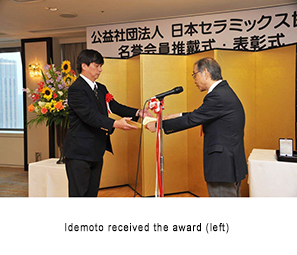| ” J-PARC News - June 2014 (Issue #110) |
| In the T2K Experiment, neutrinos generated at the Neutrino Experimental Facility of J-PARC are directed toward the Super-Kamiokande (SK) , located 295 km away in Hida City, Gifu Prefecture, with the aim of elucidating the mysteries of neutrinos. Recently the J-PARC facility began operation to produce a beam of antineutrinos - the antiparticles of neutrinos - for the first time. Path-breaking research will be conducted on violation of CP (Charge conjugation and Parity) symmetry (i.e., violation of the symmetry of matter and antimatter) by comparing the electron neutrino appearance phenomenon, which was successfully observed in 2013, with the antielectron neutrino appearance phenomenon. On June 8, the first event attributable to antineutrino beam operation was observed at SK. |
|
|
|
| Academic Achievement Award of Ceramic Society of Japan (FY2013) |
| Professor Yasushi Idemoto of the Tokyo University of Science received this award for his work "Elucidation of the Characteristic Manifestation Mechanism of Highly Functional Oxides Using a Quantum Beam and Thermodynamic Measurement." Professor Idemoto has been a long-term user of neutrons at KEK and J-PARC for the purpose of conducting R&D on new materials for lithium batteries, fuel cells, ferroelectric materials and other applications. At the MLF, he has primarily used BL08 (SHRPD) , BL20 (iMATERIA) , and BL21 (NOVA), and in recent years he has succeeded, for the first time in the world, in capturing the changes in crystal structure which occurs at the electrodes of coin-size batteries when they are charged and discharged. |
 
 * Click here to enlarge. * Click here to enlarge. |
| |
| £to Page Top |
| At present, the MLF is operating with a proton beam output of approximately 300 kW, and this beam is being utilized in experiments in 17 neutron beamlines. The graph shows the number of research proposal applications and the number of users for each year. The number of general proposal applications is increasing steadily with the increase in beam output, and this year the number of applications is expected to rise to about 700, and the number of experimenters to more than 1,000. At J-PARC, the number of proposal applications is forecast to exceed 1,000 in the future, and in order to carry out so many proposals, it will be even more important to achieve stable, user operation full-time throughout the year (9 cycles) . |
|
| At Linac, 24-hour continuous operation testing was started on June 2 for the initial accelerator section comprised of an ion source and radio frequency quadrupole linac (RFQ) . Replacement of the equipment currently in use will be performed during the summer maintenance period from July to September. |
|
| Fourth Meeting of Radiation Safety Review Committee (June 24) |
| This meeting was held in KEK Tokai Building No. 1. The people in charge at J-PARC reported on various issues such as the rotating target to be replaced in the muon experimental area of the MLF during the summer maintenance period from July to September, progress in measures to prevent recurrence of the accident at the Hadron Experimental Facility, and new target designs. The appropriateness and safety of these measures were discussed. |
| |
| £to Page Top |
|
| With the cooperation of instructors from the Tokai-mura International Center, the User's Office began elementary Japanese language classes for non-Japanese users. A total of eight classes were held. Participants eagerly participated in each class. This service will continue to be provided in the future. |
|
| At the "Science Cafe" organized by the Japan Atomic Energy Agency (JAEA) , J-PARC's public relations advisor Dr. Shinichi Sakamoto gave a talk for the general public incorporating unique experiments. The talk was entitled "The Mysteries of Neutrinos and the Higgs Particle," and covered the latest discoveries in particle physics. There was a lively question-and-answer session afterward to wrap up this worthwhile meeting. |
|
| Every year, an international exchange meeting is held at Nakamaru Elementary School in the village in order to encourage the children to take an interest in the culture of other countries. At this meeting, five assistant language teachers (ALT) from the village and 11 foreign researchers resident at the JAEA, J-PARC and other facilities participated as instructors. At the general meeting there was a welcome greeting from the children, and the instructors introduced themselves. After that, the children were divided into classes, and each teacher gave a presentation on his/her own country and answered questions from the children. Everyone ate the school lunch together, and then enjoyed some interaction time playing games outdoors and doing other activities. |
| |
| £to Page Top |
|
©2014 J-PARC Center. All rights reserved.
|
|
|